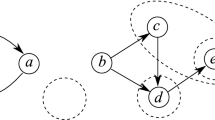Abstract
The modern notion of the axiomatic method developed as a part of the conceptualization of mathematics starting in the nineteenth century. The basic idea of the method is the capture of a class of structures as the models of an axiomatic system. The mathematical study of such classes of structures is not exhausted by the derivation of theorems from the axioms but includes normally the metatheory of the axiom system. This conception of axiomatization satisfies the crucial requirement that the derivation of theorems from axioms does not produce new information in the usual sense of the term called depth information. It can produce new information in a different sense of information called surface information. It is argued in this paper that the derivation should be based on a model-theoretical relation of logical consequence rather than derivability by means of mechanical (recursive) rules. Likewise completeness must be understood by reference to a model-theoretical consequence relation. A correctly understood notion of axiomatization does not apply to purely logical theories. In the latter the only relevant kind of axiomatization amounts to recursive enumeration of logical truths. First-order “axiomatic” set theories are not genuine axiomatizations. The main reason is that their models are structures of particulars, not of sets. Axiomatization cannot usually be motivated epistemologically, but it is related to the idea of explanation.
Similar content being viewed by others
References
Abbott E. (1935) Flatland: A romance of many dimensions. Little, Brown & Company, Boston
Aczel A. D. (2006) The artist and the mathematician: The story of Nicholas Bourbaki, the genius mathematician who never existed. Avalon, New York
Bourbaki N. (1950) The architecture of mathematics. American Mathematical Monthly 57: 221–232
Ebbinghaus H.-D. (2007) Ernst Zermelo: An approach to his life and work. Springer, Berlin
Frank Ph. (1947) Einstein: His life and times. A. A. Knopf, New York
Gödel, K. (1931). Über formal unentscheidbare Sätze der Principia Mathematica und verwandter Systeme I. Monatshefte für Mathematik und Physik, 38, 173–198. (Reprinted & translation in Collected works (Vol. 1, pp. 144–195). Oxford: Oxford University Press).
Gödel K. (1983) Russell’s mathematical logic. In: Benacerraf P., Putnam H. (eds) Philosophy of mathematics. Cambridge University Press, New York, pp 447–469
Hilbert, D. (1899). Grundlagen der Geometrie. In Festschrift zur Feier der Enthüllung des Gauss-Weber-Denkmals in Göttinge (pp. 1–92). Leipzig: Teubner.
Hilbert, D. (1900). Mathematische Probleme. In Nachrichten von der Königlichen Gesellschaft der Wissenschaften zu Göttingen, Math.-Phys. Klasse (pp. 253–297). Lecture given at the International Congress of Mathematicians, Paris.
Hilbert, D. (1918). Axiomatisches Denken. Mathematische Annalen, 8, 405–415. English translation in W. Ewald (Ed.), From Kant to Hilbert: A source book in the foundations of mathematics (Vol. 2, pp. 1105–1110). Oxford: Oxford University Press.
Hilbert D. (1922) Neubegrundung der Mathematik, Erste Mitteilung. Abandlungen aus dem Mathematischen Seminar Hamburger Universität 1: 157–171
Hintikka J. (1968) Behavioral criteria of radical translation. Synthese 19: 69–81
Hintikka J. (1996) The principles of mathematics revisited. Cambridge University Press, New York
Hintikka J. (2001) Post-Tarskian truth. Synthese 126: 17–36
Hintikka J. (2003) A distinction too few or too many? In: Gould C. (eds) Constructivism and practice. Roman and Littlefield, Lanham, MA, pp 47–74
Hintikka J. (2004a) Independence-friendly logic and axiomatic set theory. Annals of Pure and Applied Logic 126: 313–333
Hintikka, J. (2004b). On the development of Aristotle’s ideas of scientific method and structure of science. In Analyses of Aristotle (pp. 153–174). Dordrecht: Kluwer.
Hintikka J. et al (2006) Truth, negation, and some other basic notions in logic. In: Benthem J. (eds) The age of alternative logics. Springer, Heidelberg, pp 195–219
Hintikka J. (2007a) Who has kidnapped the notion of information? In: Hintikka J. (eds) Socratic epistemology, explorations of knowledge-seeking by questioning. Cambridge University Press, New York, pp 189–210
Hintikka J. (2007) Logical explanations. In: Hintikka J. (eds) Socratic epistemology, explorations of knowledge-seeking by questioning. Cambridge University Press, New York, pp 161–188
Hintikka, J. (forthcoming). Reforming logic (and set theory).
Hintikka J., Karakadilar B. (2006) How to prove the consistency of arithmetic. Acta Philosophica Fennica 78: 1–15
Laugwitz D. (1996) Bernhard Riemann 1826–1866: Wendepunkte in der Auffassung der Mathematik. Birkhäuser, Basel
Majer U. (1995) Geometry, intuition and experience: From Kant to Hilbert. Erkenntnis 42: 261–295
Majer U. (2001) The axiomatic method and the foundations of science: Historical roots of mathematical physics in Göttingen (1900–1930). In: Rédei M., Stöltzner M. (eds) John von Neumann and the foundations of quantum physics. Kluwer, Dordrecht, pp 11–34
Newton, I. (1972/1736). In A. Koyré & I. B. Cohen (Eds.), Isaac Newton’s Philosophiae Naturalis Principia Mathematica (Vol. 1). Cambridge: Harvard University Press.
Pour-El M. B., Richards J. (1989) Computability in analysis and physics. Springer, Heidelberg
Reichenbach H. (1958) The philosophy of space and time. Dover, New York
Sandu G. (1998) IF logic and truth definition. Journal of Philosophical Logic 27: 143–164
Tarski, A. (1935). Der Wahrheïtsbegriff in den formalisierten Sprachen. Studia Philosophica, 1, 261–405. English translation in Tarski (1956). Logic, semantics, metamathematics. New York: Oxford University Press.
Trisch M. (2005) Inconsistency, asymmetry, and non-locality. Oxford University Press, New York
Zermelo, E. (1904). Proof that every set can be well-ordered. Original German in Mathematische Annalen, 59, 514–516. English translation in J. van Heijenoort (Ed.). (1967). From Frege to Gödel: A sourcebook in mathematical logic 1879–1931 (pp. 139–141). Cambridge, MA: Harvard University Press.
Zermelo, E. (1908). Investigations on the foundations of set theory. Original German in Mathematische Annalen, 65, 261–281. English translation in J. van Heijenoort (Ed.). (1967). From Frege to Gödel: A sourcebook in mathematical logic (pp. 1879–1931). Cambridge, MA: Harvard University Press.
Zermelo, E. (1930). New investigations on the foundations of set theory. Original German in Fundamenta Mathematicae, 16, 29–47. English translation in W. Ewald (Ed.). (1996). From Kant to Hilbert (Vol. 2, pp. 1208–1233). Oxford: Oxford University Press.
Author information
Authors and Affiliations
Corresponding author
Rights and permissions
About this article
Cite this article
Hintikka, J. What is the axiomatic method?. Synthese 183, 69–85 (2011). https://doi.org/10.1007/s11229-009-9668-8
Received:
Accepted:
Published:
Issue Date:
DOI: https://doi.org/10.1007/s11229-009-9668-8




